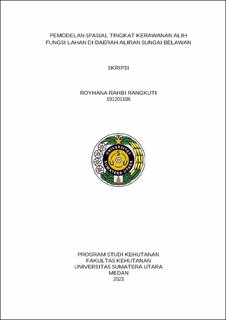| dc.description.abstract | The condition of the Belawan Watershed is currently experiencing changes
in land use along with increasing population and industrial development and is
one of the watersheds in Indonesia that has experienced degradation in the last
ten years, but there has been no serious handling and attention from both the
local government and the community. This study aims to analyze the level of
vulnerability to land use change and analyze changes in carbon emissions in the
2012-2022 period. Land cover data analysis uses Google Earth Engine as the
main data and shaman data, namely data obtained from DEM data from SRTM,
as well as data collected, namely spatial data in the form of digital maps of roads,
digital maps of rivers, digital maps of administration, as well as nonspatial data
in the form of population density data and per capita income level data. Analysis
of carbon emissions obtained through the application of Red Abacus Sp. The
results showed that the land conversion vulnerability class was dominated by the
moderate to very vulnerable vulnerability class which reached an area of
66,399.02 Ha out of 73,173.30 Ha of the total land area in the Belawan
Watershed or reached 90.74%. The value of carbon emissions that occurred in the
Belawan watershed in the period 2012 to 2022 is 7,811,061.63 tons CO2-
eq/ha/year. In all land cover classes, those that are most vulnerable to land
conversion are plantation and residential land cover. | en_US |


